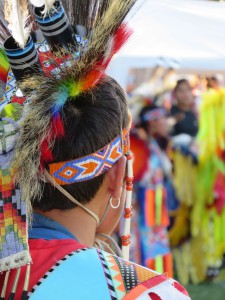By Anonymous, November 25 2015
 President Obama has proclaimed November as "Native American Heritage Month." This is a time to celebrate the many significant historic and contemporary contributions of American Indians and Alaska Natives, a population of 5.4 million people in the United States, according to the U.S. Census Bureau. In the juvenile justice field, this month is not only a time to celebrate Native American heritage, but also an opportunity to make visible the unique youth justice challenges faced by Native American communities, and to highlight steps for collaboratively working with tribal communities to improve conditions for Native American youth and their families.
President Obama has proclaimed November as "Native American Heritage Month." This is a time to celebrate the many significant historic and contemporary contributions of American Indians and Alaska Natives, a population of 5.4 million people in the United States, according to the U.S. Census Bureau. In the juvenile justice field, this month is not only a time to celebrate Native American heritage, but also an opportunity to make visible the unique youth justice challenges faced by Native American communities, and to highlight steps for collaboratively working with tribal communities to improve conditions for Native American youth and their families.
Though 1990 was the first year "Native American Indian Heritage Month" was recognized as a national legal holiday, according to the U.S. Bureau of Indian Affairs, the pursuit of a holiday to celebrate heritage began in the early 20th century when Dr. Arthur C. Parker - a Seneca Indian and director of the Museum of Arts and Sciences in Rochester, New York - promoted a day to celebrate "First Americans." In May 1916, the first "American Indian Day" was declared by the state of New York, and many states observed a version of this day for years before official national recognition in 1990 for the month of November.
While in 2013 Native Americans made up only about two percent of the United States population, according to the U.S. Census Bureau, the National Congress of American Indians (NCAI) finds that states such as Alaska, Oklahoma, and New Mexico have considerable Native populations, ranging from 10.7 to 19.5 percent of their total state populations. NCAI also significantly reports that 32 percent of Native Americans are under age 18, compared to only 24 percent for the total U.S. population.
For Native American Heritage month, The Oklahoman interviewed its American Indian readers on "how they keep their culture strong in their homes and communities," and found an emphasis on educating the high percentage of youth about their history and heritage, but also on concerns specifically facing Native American youth and their families - which includes poverty, high suicide rates, teen pregnancy, dropping out of high school, substance use, and high rates of incarceration by way of the school-to-prison pipeline.
Arizona Public Media wrote earlier this year, based on a series of recent reports, that the U.S. juvenile justice system is failing Native American Youth. One report in June called for reform, stating their finding that more than any other racial or ethnic group, states are far more likely to incarcerate Native youth for minor crimes; and the Indian Law & Order Commission finds there to be disproportionately high numbers of Native youth in juvenile detention facilities.
In October of this year, a report was released by the U.S. Department of Education finding that Native American youth are disciplined at a much higher rate than students of other ethnicities, and especially Native American girls. The report also highlighted a high rate of bullying and a need to improve overall school climate in order to create a healthier, safer, and more accepting learning environment for Native American students and keep them out of the school-to-prison pipeline. One solution to these issues that is now pursued, in light of this report, is the implementation of American Indian Studies and Native American studies programs at the K-12 level.
Indian Country Today and Noodle recommended best practices when working with Native American students, which include:
- Promote the significance of Native American Heritage Month and this month's presidential proclamation to Native and non-Native youth
- Advocate for positive school discipline, which may include cultural responsiveness training for educators
- Discourage bullying and foster cultural awareness, understanding and appreciation
- Accurately teach Native American history and experience to Native and non-Native students; recognize the diversity of tribal nations
- Evaluate school mascots and imagery which may cause stress, anxiety, confusion and embarrassment
- Appropriately identify students with disabilities (Native Americans have one of the highest rates of disability in the United States, according to the U.S. Department of Justice)
For behavioral health professionals, the National American Indian and Alaska Native ATTC recommends the acknowledgement of spirituality. While spirituality is known to aid in recovery from substance use by Native Americans, not a lot of published research on Native substance use treatment assesses spirituality in relation to treatment (Greenfield, Hallgreen, Venner et al, as cited in Thompson, 2015). White Bison, Inc., which created the Wellbriety Movement, is an example of one organization to offer culturally-based healing and recovery treatment with Native Americans in mind.
While Aljazeera America reports "mixed educational success," from President Obama's recent initiatives - like the Generation Indigenous (Gen-I) Initiative which aims to improve the lives of Native American youth - a rise in Native American studies programs, and new resources like Native One Stop, implemented to improve the lives of Native youth, provide sustained hope for the visibility, recognition and celebration of Native American youth and their communities on all months of the year.
Topics: Adolescent Substance Abuse Treatment, Juvenile Justice Reform, Native American, News, Positive Youth Development, Resources, school, school discipline, School-to-Prison Pipeline, schools
Updated: September 23 2020
